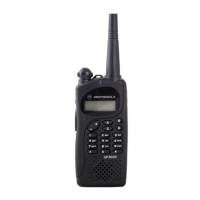Theory of Operation 7-5
6. This personality data is used to initialize the radio.
7. The radio restores last power up state (i.e. state before the radio was turned-off).
8. Power is supplied to PLL circuitry.
9. Power is supplied to Rx and Rx VCO circuitry.
10. CPU sends data to PLL circuitry. If LOCK status is conÞrmed, radio continues the power-up
sequence. Otherwise, PLL ERR is displayed.
11. If the Rx audio level is less than the pre-programmed squelch level, and other unmuting con-
ditions are met, the radio will open squelch.
3.4 CPU / Control Section
When the radio is turned ON, the CPU (Q101) reads the radio status from the EEPROM Q114. It
also monitors the keypad, the PTT line and other inputs such as the squelch detect, etc.
continuously. When there is a channel change, the CPU sends the correct frequency information to
the synthesizer via pins 2, 87 and 100. The CPU is clocked by the 8.388608MHz oscillator, which is
composed of X101, C101, C106, and R158.
3.5 VCO / Synthesizer Section
This section consists of the Temperature-Compensated Crystal Oscillator(TCXO), Voltage
Controlled Oscillator(VCO), Synthesizer and the Loop Filter. These circuits are found on the RF
board.
3.5.1 Temperature-Compensated Crystal Oscillator (TCXO)
The reference oscillator is a temperature compensated crystal-controlled, Pierce type circuit. It
utilizes a logic gate within Q323 as a gain element. C335 is used to adjust the oscillator on
frequency (14.4MHz) at room temperature (22ûC). Temperature variations cause resistance
changes in thermistor R330 and R567, which is on the base of Q320, thus varying the voltage
applied to varactor Q322. This changes the impedance across crystal X301 in a manner
complementary to the temperature drift characteristic of the crystal. In this way, the reference
oscillator is held within the speciÞed ±2.5 PPM from -30 to +60ûC.
3.5.2 Voltage-Controlled Oscillators
Only one of the VCOs runs at a time, which is controlled by Q310 and Q101. The receive VCO
consists of C344-C351, L302, L305, L306, L312-L314, Q311, and Q324. This VCO oscillates at
45.1 MHz above the programmed receive frequency. The VCOÕs oscillating frequency is tuned by
the varactor Q311. The tuning voltage is supplied from the output of the Loop Filter. The output of
the VCO is AC coupled (C352) to the synthesizer and the output buffer Q308 respectively. The
output of the VCO buffer Q308 is AC coupled (C475 and R422-R444, C312, C313) to the
synthesizer and the output buffer Q416 respectively.
When the PTT is pressed, Q101 pin36 goes low (approx. 0V) disabling the receive VCO by the
Q310 and biases on Q309 to enable the transmitter VCO. The transmitter VCO consists of C353,
C355, C357, C358, L315, L317, L318, Q325, Q326, Q329, and Q342. This VCO oscillates on the
programmed transmit frequency. The VCOÕs oscillating frequency is tuned by the varactor Q326.
The tuning voltage is supplied from the output of the Loop Filter. The transmit voltage controlled
oscillator is directly frequency-modulated and operates on the carrier frequency. The synthesizer is
tuned in 5.00kHz or 6.25kHz steps.

